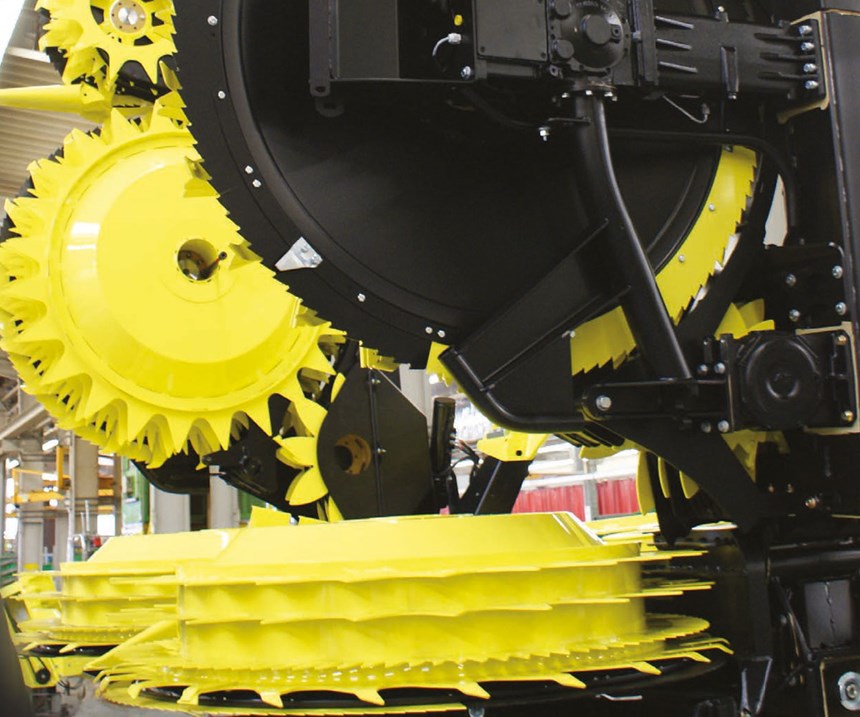Ag Machinery Maker Kemper Saves Time with Faster Color Change
Productivity increased due to the new fast color change booth.
Edited by Angela Osborne
Agricultural machinery manufacturer Kemper has gained an excellent reputation in its more than 100-year history. Many renowned manufacturers purchase these harvesting attachments from Germany-based Kemper, ranging from the parent company John Deere to New Holland, Agco and even Russian manufacturers. Kemper also manufactures header attachments for Claas and Krone forage harvester, and supplies them to the market.
A staff of about 300, who are members of a variety of different trades (from welding to machining technicians), work in the expansive factory buildings. Finishing the parts starts in a 13-zone spray pretreatment with zinc phosphate. The cathodic dip coating process follows next, and a light gray is applied because Kemper uses many shades of light paints.
Featured Content
Individualization, increasing demands on the appearance and the customer’s corporate colors are becoming more and more important, even in the area of mowing equipment.
“We are at a point where many of our customers receive their harvest attachments painted in their corporate colors right off the conveyor belt,” says Stefan Plate, system operator at Kemper.
In 2012, they invested in a new application technology from Nordson that included a color change with its new ColorMax 3 that was possible within 4 minutes and 15 seconds.
“In addition to the short color change times, the ergonomic design of the new booth is much better for our employees,” says Plate. “We are using 10 automatic spray guns, whereby two can be used from underneath, if demand requires it.”
Color Change
On average, the new booth makes it possible to coat 85% of the component’s surface automatically, and Plate estimates that the new booths save about 33% of the compressed air required. Only two people are required to proceed with the color change — one person for the precoating and one for the postcoating process.
If a color change becomes necessary, Plate says the technician prepares a gap in the chain conveyor of 25 links, equal to the length of a paint booth. As soon as the precoating is done and the powder is used, the technician closes the rear door and goes to the powder center, where he interrupts the powder supply from the carton.
Plate says he also places the previous powder carton underneath the hopper in order to collect the powder residue. Once the last part is coated, the technician at the postcoating station presses the color-changing button. From now on, the control system sets the cycle and starts the cleaning program.
When Kemper changes four colors today in only 4 minutes and 15 seconds per day, Plate says it takes only 17 minutes. Previously, it took 10 1/2 minutes to change the booth just once. Therefore, four color changes means a 42-minute pause of coating time. In addition, Plate says there was the manpower requirement in order to proceed with the actual change of colors offline in 45 minutes in each of the change booths.
This clearly demonstrates how drastically the productivity increased due to the new, fast color change booth. On average, the coating process at Kemper takes place over nine hours per day, whereby the start of the work shifts are staggered, depending on the advancement of the parts on the 700-meter-long endless chain conveyor system. This means that the technicians can sleep three hours longer, while the suspension trolleys start their shift already at 5:30 a.m. At about 8:30 a.m., the first components have passed through the pretreatment and CDC station, and arrive at the paint coating hall. After about six hours, the first parts are ready to be removed from the suspension trolley.
Information provided by Nordson. Visit nordson.com
RELATED CONTENT
-
Proper Testing of a Powder Coat Finish
Manufacturer shows how it performs extensive tests on powder coated medical carts.
-
Powder Coat MDF for an Enviable Finished Product
Cabinet maker says powder coating on wood offers more benefits.
-
Calculating Oven Heat Load Capacity
Please explain how to calculate the heat load capacity of a paint baking oven, using aluminum alloy wheels as an example.





















